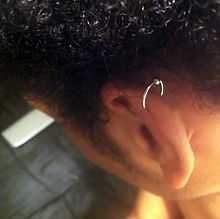Helix piercing
| Helix piercing | |
|---|---|
 | |
| Nicknames | Cartilage ring |
| Location | Cartilage |
| Jewelry | Captive bead ring, stud |
| Healing | 6 to 12 months |
The helix piercing is a perforation of the helix or upper ear (cartilage) for the purpose of inserting and wearing a piece of jewelry. The piercing itself is usually made with a small gauge hollow piercing needle, and typical jewelry would be a small diameter captive bead ring, or a stud.
Sometimes, two helix piercings hold the same piece of jewelry, usually a barbell, which is called an industrial piercing.
Piercing process
A sterile needle is pushed through the cartilage and then kept in while the jewelry is added. This can be painful, depending on the individual's pain threshold, and bleeding and swelling are expected after the piercing process, especially if the jewelry is bumped or snagged on hair or clothing.
After care
Like all new piercings, helix piercings should be touched as little as possible. Contact with other body fluids, pools, puddles, makeup and beauty sprays, etc. is generally discouraged. Unwashed hands carry bacteria and may cause infections. Twisting the jewellery is also not recommended as this can tear and irritate the fistula (the healing skin inside the hole) which can lead to hypertrophic scarring, a prolonged healing period, migration and in some cases rejection of the piercing.
Cleaning can be done by simply allowing warm water (such as from a shower) to wash over the jewelry, or by spraying the piercing with sterile saline. It is possible to soak a sore or irritated piercing in warm saline (0.9% salinity, or "normal saline"), or to make a similar salt water solution by adding 1/4 tsp non iodized salt (rock/sea salt is usually suggested) to 8 oz warm water.
Antimicrobial soaps containing chloroxylenol or triclosan can often be irritating and are not recommended for routine use. However they may be helpful if a piercing contacts a dirty environment.
Some localized swelling or tenderness after piercing is normal as is the secretion of lymphatic fluid which tends to be clear or a pale yellow in appearance. This is not a sign of infection. The lymphatic fluid often builds up around the exit holes of the piercing and forms a crusty substance, which is easily removed during cleaning. It is important to avoid "picking" at the crust as this introduces bacteria to the wound and irritates the piercing.
Healing
The helix piercing can take up to twelve months to heal, although most piercers state that you can change the stud, bar or equivalent after around two or three months. The average healing time for helix piercings is six to eight months.
References
| ||||||||||||||||||||||||||||||||||